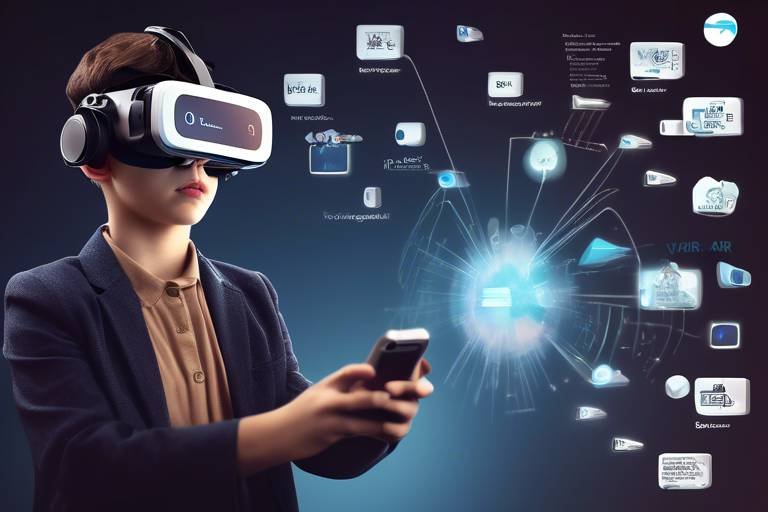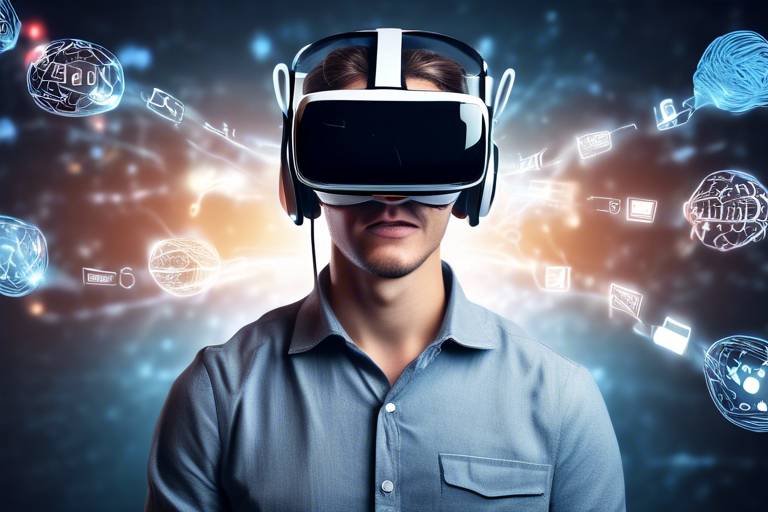Virtual Reality in Tourism: Exploring Destinations Differently
Have you ever wished you could teleport to a far-off destination without the hassle of packing your bags or booking flights? Well, thanks to virtual reality (VR), that dream is becoming a reality! This cutting-edge technology is revolutionizing the way we experience travel, allowing us to explore exotic locations from the comfort of our own homes. Imagine strolling through the vibrant streets of Tokyo or lounging on a sun-kissed beach in the Maldives—all before you even set foot on a plane. This article delves into the transformative impact of VR on the tourism industry, highlighting how it enhances travel experiences and reshapes destination exploration.
In recent years, the tourism industry has witnessed a significant shift towards embracing virtual reality technology. No longer just a novelty, VR has gained traction as a powerful tool for both travelers and businesses. With immersive experiences that allow potential tourists to explore destinations virtually, VR is changing the game in travel decision-making. Imagine being able to preview a hotel room, walk through a museum, or even take a guided tour of a city—all through your VR headset. This growing popularity is not just a trend; it's a fundamental change in how we perceive and plan our travels.
So, what exactly does VR bring to the table for travelers? The advantages are numerous and quite compelling. For starters, VR offers a unique way to experience destinations. Instead of relying solely on photos or reviews, travelers can immerse themselves in the sights and sounds of a location. This not only enhances their understanding of what to expect but also helps them make more informed decisions about their travel plans. For instance, a traveler can virtually explore the bustling markets of Marrakech or take a scenic hike through the Swiss Alps, all without leaving their living room. This capability can significantly influence their ultimate travel choices.
Tourism boards and businesses are increasingly leveraging VR to create engaging promotional content that captivates potential tourists. By offering immersive experiences, they can showcase the best their destinations have to offer in a way that traditional marketing simply cannot match. Imagine watching a stunning VR video that transports you to a tropical paradise, complete with the sound of waves crashing and the scent of salt in the air. This kind of marketing not only attracts visitors but also fosters a deeper emotional connection with the destination.
One of the most exciting aspects of VR in tourism is the rise of interactive tours. These experiences allow travelers to engage with local culture and attractions in a hands-on manner. For example, a VR tour of a historic site might include interactive elements where users can learn about the history and significance of artifacts or even participate in cultural activities, such as cooking a traditional dish. These immersive experiences make travelers feel more connected to the places they visit, enhancing their overall journey.
Planning a trip can be a daunting task, often involving extensive research and the risk of costly mistakes. However, VR can streamline this process, saving both time and money. By allowing travelers to virtually explore destinations, they can identify their must-see attractions, preferred accommodations, and even local dining options before making any commitments. This not only helps avoid disappointing experiences but also ensures travelers get the most out of their trips.
Despite its many benefits, VR in tourism does face some challenges. High costs of VR technology and the need for specialized equipment can be barriers to entry for both businesses and travelers. Additionally, not everyone has access to the necessary technology or the know-how to use it effectively. These limitations can hinder widespread adoption, but as technology evolves and becomes more accessible, the potential for VR in tourism will likely continue to grow.
The future of VR in tourism is looking bright, with advancements in technology and increasing accessibility paving the way for exciting developments. As VR continues to evolve, we can expect to see even more innovative applications that enhance the travel experience.
One of the most promising trends is the integration of VR with augmented reality (AR). This combination offers incredible possibilities for creating even more immersive travel experiences. Imagine using AR to overlay information about historical sites as you explore a city, or using VR to visualize a destination while standing in your living room. The synergy between these technologies could redefine how we experience travel.
As VR technology matures, the potential for personalized travel experiences will become increasingly prevalent. By analyzing individual preferences and interests, VR can tailor experiences to suit diverse audiences. For instance, a family planning a vacation could explore kid-friendly attractions, while a couple seeking romance might preview intimate dining options. This level of personalization can make travel planning not only easier but also more enjoyable.
- What is virtual reality? Virtual reality is a technology that creates immersive digital environments, allowing users to experience places and activities as if they were physically present.
- How can VR enhance travel experiences? VR allows travelers to explore destinations virtually, helping them make informed decisions about where to go and what to do.
- Are there any challenges to using VR in tourism? Yes, challenges include high costs, technological barriers, and limited access for some users.
- What is the future of VR in tourism? The future looks promising, with trends like integration with AR and personalized experiences shaping the landscape of travel.

The Rise of Virtual Reality in Tourism
Virtual reality (VR) technology is not just a trend; it has become a game-changer in the tourism industry. Over the past few years, we have witnessed a remarkable surge in the adoption of VR, transforming how travelers experience and engage with destinations. Imagine being able to stroll through the streets of Paris, stand in front of the Eiffel Tower, or dive into the crystal-clear waters of the Great Barrier Reef—all from the comfort of your living room. This is the magic of VR!
As more travelers seek unique and immersive experiences, the demand for VR in tourism has skyrocketed. According to recent studies, the global virtual reality market in tourism is expected to reach billions of dollars in the coming years, reflecting its growing popularity. The technology allows potential tourists to preview attractions, accommodations, and even local cultures, making it easier to decide where to spend their hard-earned vacation time and money.
In addition to enhancing the travel experience, VR also plays a crucial role in destination marketing. Tourism boards and travel agencies are leveraging this technology to create captivating promotional content that draws in visitors. By offering virtual tours and experiences, they can showcase the best their destinations have to offer, making it easier for travelers to visualize their upcoming adventures. This innovative approach not only piques interest but also significantly increases the chances of bookings.
Furthermore, the rise of VR has opened up new avenues for accessibility in tourism. Individuals who may have physical limitations or financial constraints can now explore the world virtually. This democratization of travel experiences is a significant step towards inclusivity, allowing everyone to enjoy the beauty and culture of different places without the usual barriers.
With VR technology becoming more affordable and user-friendly, its applications in tourism are expanding rapidly. From virtual hotel tours to immersive cultural experiences, the possibilities are endless. As we look to the future, it's clear that VR is not just a passing fad; it's reshaping the landscape of travel and tourism in ways we never thought possible.

Benefits of VR for Travelers
Imagine being able to step into the vibrant streets of Tokyo or the serene beaches of Bali without ever leaving your living room. Virtual reality (VR) offers travelers a unique opportunity to experience destinations like never before. This technology is not just a gimmick; it's revolutionizing how we plan and enjoy our travels. With VR, you can preview attractions, accommodations, and activities, making informed decisions that enhance your travel experience. Let's dive into some of the key benefits that VR brings to the table for travelers.
One of the most significant advantages of VR is the ability to preview destinations before you commit. Travelers can explore virtual representations of hotels, tourist spots, and even local cuisine, which helps in visualizing the experience. This immersive preview can be a game-changer for those who are indecisive about where to go. For instance, if you are torn between a beach resort in the Caribbean and a mountain retreat in the Alps, a VR tour can help you feel the ambiance of each place, tipping the scales in favor of one option.
Moreover, VR enhances destination marketing for tourism boards. Instead of relying solely on brochures or videos, many destinations are now offering VR experiences that allow potential tourists to immerse themselves in the local culture and attractions. Imagine walking through the ancient ruins of Rome or exploring the lush landscapes of New Zealand—all from the comfort of your home. This engaging content captivates the audience, making them more likely to choose that destination for their next vacation.
Another noteworthy benefit is the interactive nature of VR. Interactive tours allow travelers to engage with the environment actively. For example, you can take a virtual cooking class in Italy, learn about local traditions, or even participate in a guided tour of a historic site. This hands-on approach not only makes the experience more enjoyable but also fosters a deeper connection to the destination. It’s like having a personal tour guide who can show you around, answering your questions in real-time!
Additionally, using VR for travel planning can be cost-effective. Picture this: you’ve booked a hotel based on a few pictures online, only to find it doesn’t meet your expectations upon arrival. With VR, you can avoid such costly mistakes. By exploring a hotel room or a resort's amenities virtually, you can ensure that what you see is what you get. This level of transparency can save you from unpleasant surprises and help you find the perfect accommodation that fits your needs.
In summary, virtual reality is not just about fancy gadgets and tech wizardry; it's a powerful tool that enhances the travel experience in multiple ways. From immersive previews and interactive tours to cost-effective planning, the benefits of VR for travelers are vast and varied. As technology continues to evolve, we can only expect these advantages to grow, making travel planning and experiences even more enriching.
- What is virtual reality in tourism?
Virtual reality in tourism refers to the use of VR technology to create immersive experiences that allow travelers to explore destinations, attractions, and accommodations before physically visiting them. - How can VR enhance my travel planning?
VR allows you to preview hotels, attractions, and local experiences, helping you make informed decisions and avoid costly mistakes. - Are there any downsides to using VR for travel?
While VR offers many benefits, challenges include high costs for creating quality content and the need for specific technology to access VR experiences. - Will VR replace actual travel?
No, while VR can enhance the travel experience and aid in planning, it cannot replicate the full sensory experience of being in a new place.

Enhanced Destination Marketing
In the ever-evolving landscape of tourism, virtual reality (VR) has emerged as a game-changer for destination marketing. Imagine being able to step into a vibrant market in Marrakech or wander through the stunning streets of Paris without leaving your living room. This is not just a dream; it’s the new reality that tourism boards and travel companies are leveraging to attract potential visitors. With VR, the traditional marketing methods of brochures and static images are being replaced by immersive experiences that allow travelers to truly feel the essence of a destination before they even set foot there.
One of the most significant advantages of VR in destination marketing is its ability to create engaging and interactive content. Instead of simply telling potential tourists about a destination, VR allows them to experience it firsthand. For instance, a VR tour of a famous landmark can transport users into the heart of the experience, showcasing not only the visual beauty but also the sounds and atmosphere that make a place unique. This level of immersion can significantly influence travel decisions, as travelers are more likely to choose a destination that they feel a personal connection to after experiencing it through VR.
Moreover, tourism boards are beginning to adopt 360-degree videos and VR experiences to showcase their offerings. These tools allow potential visitors to explore various attractions, accommodations, and local cultures from the comfort of their homes. For example, a tourist board might create a VR experience that highlights a local festival, giving users a taste of the vibrant culture and community spirit. This not only enhances the marketing appeal but also fosters a deeper understanding of what the destination has to offer.
To illustrate the impact of VR on destination marketing, consider the following table that outlines some successful VR marketing campaigns:
| Destination | VR Experience | Outcome |
|---|---|---|
| New Zealand | Virtual tours of scenic landscapes | Increased tourist inquiries by 30% |
| Dubai | 360-degree experiences of attractions | Boosted bookings for local tours by 25% |
| Japan | Interactive cultural experiences | Enhanced engagement on social media platforms |
As we can see, the results speak for themselves. These campaigns not only draw attention but also convert interest into bookings. The immersive nature of VR experiences can lead to higher engagement rates, as users are more likely to share their experiences online, creating a ripple effect that can attract even more visitors.
In conclusion, the integration of virtual reality into destination marketing is not just a trend; it's a revolution in how we promote travel experiences. By providing potential tourists with the ability to explore destinations virtually, tourism boards can create a powerful emotional connection that translates into real-world visits. As this technology continues to evolve, we can expect to see even more innovative applications that will redefine how destinations are marketed and experienced.

Interactive Tours and Experiences
When we think about traveling, we often envision ourselves wandering through ancient ruins, tasting exotic foods, or soaking up the sun on a pristine beach. But what if you could experience all of this without ever leaving your home? That's where interactive virtual reality (VR) tours come into play, transforming the way we explore destinations. These innovative experiences allow travelers to engage with local culture, attractions, and activities in a way that feels almost real, providing a sneak peek into what awaits them on their journey.
Imagine slipping on a VR headset and being transported to the bustling streets of Tokyo, where you can stroll through the vibrant markets, interact with street vendors, and even participate in a traditional tea ceremony—all from the comfort of your living room. This is not just a fantasy; it's a reality that many tourism companies are embracing to give potential travelers a taste of their offerings.
One of the most exciting aspects of interactive tours is their ability to create a sense of presence. Users can look around, move their heads, and even use hand gestures to interact with the environment. This immersive experience allows them to:
- Explore iconic landmarks up close, like the Eiffel Tower or the Great Wall of China.
- Experience thrilling adventures, such as zip-lining through a rainforest or scuba diving in vibrant coral reefs.
- Engage with local communities, learning about their customs and traditions firsthand.
Moreover, interactive VR experiences are not just limited to sightseeing. They can also include educational components, such as guided tours led by local experts who share fascinating stories and insights about the area. This blend of entertainment and education enriches the travel experience, making it more meaningful and memorable.
As we look to the future, the potential for interactive tours is vast. With advancements in technology, we can expect even more realistic simulations and engaging experiences. Imagine being able to customize your virtual tour based on your interests—whether it's art, history, or culinary delights. The possibilities are endless, and as VR continues to evolve, so too will the ways in which we explore the world.
In conclusion, interactive VR tours are revolutionizing the travel landscape, offering a unique way to discover new destinations and cultures. They not only enhance the decision-making process for travelers but also create a deeper connection to the places they plan to visit. So, whether you're a seasoned globetrotter or a curious explorer, interactive VR experiences can open up a world of adventure right at your fingertips.
1. What technology do I need to experience VR tours?
To enjoy interactive VR tours, you typically need a VR headset, such as an Oculus Rift, HTC Vive, or even a mobile VR headset like Google Cardboard. Additionally, a compatible smartphone or computer may be required depending on the platform.
2. Are VR tours suitable for everyone?
While VR tours can be enjoyed by most people, some individuals may experience motion sickness or discomfort. It's always a good idea to take breaks and ensure that the VR experience is suitable for your personal comfort level.
3. Can I access VR tours on my smartphone?
Yes! Many VR experiences are designed to be accessible on smartphones, allowing users to explore destinations with just a headset and their mobile device.
4. How do interactive tours enhance my travel planning?
Interactive tours allow you to preview destinations, attractions, and accommodations, helping you make informed decisions about where to go and what to do. This can lead to a more enjoyable travel experience and help you avoid costly mistakes.

Cost-Effective Travel Planning
When it comes to planning a trip, the excitement of exploring new destinations often collides with the reality of budgeting and costs. This is where virtual reality (VR) steps in as a game-changer. Imagine being able to virtually step into a hotel room, stroll through a bustling market, or even hike a scenic trail—all from the comfort of your living room. By utilizing VR technology, travelers can engage in that not only saves money but also enhances their overall experience.
One of the most significant advantages of VR in travel planning is the ability to preview accommodations. Before booking a hotel, travelers can take a virtual tour of the property, exploring amenities, room layouts, and even the surrounding area. This immersive experience allows them to make informed decisions, ensuring they choose accommodations that truly meet their needs. No more unpleasant surprises upon arrival! By seeing what a hotel actually looks like, travelers can avoid spending money on a place that doesn't live up to their expectations.
Furthermore, VR can help travelers assess various attractions and activities, leading to smarter choices about where to spend their time and money. For example, a traveler interested in visiting a theme park can take a virtual ride on a roller coaster or explore the park layout before purchasing tickets. This not only enhances their anticipation but also allows them to plan their day more efficiently, avoiding costly mistakes like missing out on must-see attractions or overspending on unnecessary extras.
Additionally, VR can serve as a valuable tool for comparing different destinations. Imagine wanting to visit both Paris and Rome but being unsure which one to choose. With VR, you can take a virtual stroll along the Seine, followed by a quick jaunt through the streets of Trastevere. This firsthand experience can be the deciding factor in your travel plans, helping you avoid the regret of choosing one destination over another without truly knowing what you might be missing.
Moreover, using VR for travel planning can significantly reduce the need for costly in-person visits to travel agencies or extensive research online. Instead of sifting through countless reviews and photos, travelers can experience destinations in a more authentic way, leading to quicker and more confident booking decisions. This efficiency not only saves time but also minimizes the chances of overspending due to impulse decisions made during the planning process.
In summary, the integration of VR into travel planning offers a cost-effective solution that empowers travelers to make informed choices. By previewing accommodations, assessing attractions, comparing destinations, and streamlining the planning process, VR technology transforms the way we approach travel. The result? A more enjoyable, budget-friendly travel experience that maximizes both excitement and value.
- How does VR help in planning travel? VR allows travelers to virtually explore destinations, accommodations, and attractions, enabling informed and confident decision-making.
- Is VR technology expensive to use for travel planning? While the initial investment in VR technology can be high, many travel companies offer free or low-cost VR experiences that can save travelers money in the long run.
- Can VR replace traditional travel experiences? While VR provides a unique way to preview destinations, it is best used as a complementary tool rather than a replacement for the real experience.

Challenges and Limitations of VR in Tourism
While virtual reality (VR) is revolutionizing the tourism industry, it’s essential to acknowledge that this innovative technology comes with its own set of challenges and limitations. One of the most significant hurdles is the high cost of VR equipment and development. For many small businesses and local tourism boards, investing in VR technology can feel like a leap into the unknown. The initial outlay for quality VR headsets, software, and the necessary hardware can be daunting. Moreover, creating high-quality VR content requires specialized skills, which can further inflate costs.
Another challenge is the technological barrier that exists for both consumers and businesses. Not everyone has access to the latest VR technology, and many potential users might find the setup process complicated or intimidating. This can lead to a digital divide, where only tech-savvy travelers can fully benefit from VR experiences. Additionally, there are concerns about the user experience. If VR experiences are not intuitive or engaging enough, they may fail to capture the interest of potential tourists, leading to wasted resources.
Furthermore, there are health concerns associated with VR usage, such as motion sickness and eye strain. Many users report feeling disoriented or nauseous after extended periods of VR immersion. This can deter some travelers from embracing VR as part of their planning process. Additionally, the lack of standardization in VR content creation can lead to inconsistencies in quality. Not all VR experiences are created equal, and this disparity can affect travelers' perceptions of a destination.
In terms of content availability, not all destinations have the resources to create compelling VR experiences. While major tourist spots may have access to high-quality VR content, lesser-known locations might struggle to showcase their unique offerings. This can lead to an uneven playing field in destination marketing, where only the most popular places receive the attention they deserve.
Lastly, there’s the question of privacy and data security. As VR technology often requires personal data to enhance user experiences, concerns about how this data is collected, stored, and used are increasingly relevant. Travelers may be hesitant to engage with VR platforms if they feel their privacy might be compromised.
In summary, while the potential of VR in tourism is vast and exciting, it is accompanied by significant challenges. Addressing these limitations will be crucial for the widespread adoption and success of VR technology in the tourism industry. As we move forward, it will be interesting to see how businesses adapt and innovate to overcome these obstacles.
- What are the main challenges of using VR in tourism? The main challenges include high costs, technological barriers, health concerns, content availability, and privacy issues.
- Can VR replace traditional travel experiences? While VR enhances travel planning and offers unique previews, it cannot completely replace the physical experience of travel.
- How can businesses overcome the limitations of VR? By investing in user-friendly technology, creating high-quality content, and addressing privacy concerns, businesses can improve VR adoption.

Future Trends in Virtual Reality and Tourism
The future of Virtual Reality (VR) in tourism is not just bright; it's bursting with potential! As technology continues to advance at a breakneck pace, we are on the brink of a revolution that will redefine how we experience travel. Imagine being able to step into a virtual world that transports you to the bustling streets of Tokyo or the serene beaches of Bali, all from the comfort of your living room. This isn’t just a fantasy; it’s becoming a reality, and the trends emerging in VR technology are paving the way for a new era in tourism.
One of the most exciting trends is the integration of VR with Augmented Reality (AR). This combination is like a match made in tech heaven, enhancing the travel experience by overlaying digital information onto the real world. For instance, imagine walking through the historic streets of Rome, and as you look through your VR headset, you can see ancient ruins reconstructed in their original glory, complete with interactive guides and historical facts popping up in real-time. This kind of immersive experience not only brings history to life but also engages travelers on a deeper level, making them feel like they are part of the story.
Another trend that’s gaining momentum is the push for personalized travel experiences. As VR technology evolves, it will increasingly cater to individual preferences and interests. Picture this: you’re planning a trip, and instead of generic travel packages, you have the option to create a tailor-made virtual experience that aligns perfectly with your hobbies and desires. Whether you’re an adventure seeker, a foodie, or a culture enthusiast, VR can curate unique itineraries that resonate with your personal style. This level of customization not only enhances satisfaction but also fosters a deeper connection between travelers and their chosen destinations.
Moreover, the accessibility of VR technology is set to improve significantly. As headsets become more affordable and user-friendly, we can expect a surge in their adoption among both tourists and travel agencies. This democratization of technology means that more people will have the opportunity to experience virtual travel, breaking down barriers that once limited access to such innovative tools. In fact, we can foresee a future where even remote or underserved destinations can promote their unique offerings through immersive VR experiences, attracting a broader audience.
Lastly, we can’t overlook the role of social media integration in the evolution of VR tourism. Imagine sharing your virtual travel experiences with friends and family in real-time, allowing them to join you on your journey from anywhere in the world. This kind of connectivity not only enhances the travel experience but also creates a sense of community among travelers, as they can share tips, experiences, and recommendations instantly. Social media platforms are already beginning to incorporate VR elements, and this trend is likely to grow, making travel more interactive and engaging than ever before.
In summary, the future of VR in tourism is not just about technology; it’s about transforming the way we explore the world. With advancements in AR, personalized experiences, improved accessibility, and social media integration, travelers will soon have the tools to embark on adventures like never before. So, buckle up and get ready for a thrilling ride into the future of travel!
- What is Virtual Reality in tourism?
Virtual Reality in tourism refers to the use of VR technology to create immersive experiences that allow travelers to explore destinations virtually before visiting them in person. - How can VR enhance travel planning?
VR allows travelers to preview attractions, accommodations, and activities, helping them make informed decisions and avoid costly mistakes. - What are the challenges of using VR in tourism?
Some challenges include high costs, technological barriers, and the need for widespread adoption among both travelers and tourism providers. - What future trends can we expect in VR tourism?
Future trends include the integration of VR with Augmented Reality, personalized travel experiences, improved accessibility, and enhanced social media connectivity.

Integration with Augmented Reality
The fusion of Virtual Reality (VR) and Augmented Reality (AR) is creating a revolutionary shift in how we experience travel. Imagine standing in your living room, wearing a VR headset, and being transported to the bustling streets of Tokyo, where digital enhancements overlay the real-world environment around you. This integration allows travelers to not only explore destinations but also interact with their surroundings in a way that feels both authentic and immersive. By combining the digital and physical worlds, tourism experiences become richer and more engaging.
One of the most exciting aspects of this integration is the ability to enhance cultural experiences. For instance, when visiting historical sites, AR can provide real-time information about the architecture, historical events, or even the people who once inhabited those spaces. Imagine walking through the ruins of a Roman amphitheater and seeing a holographic gladiator reenacting a battle, all while your VR headset overlays this scene onto the real environment. This not only enriches the experience but also deepens the traveler’s understanding of the destination.
Moreover, the combination of VR and AR can significantly enhance travel planning. Travelers can use AR applications to visualize hotel rooms, restaurants, and attractions before making a reservation. For example, a user could point their smartphone at a hotel building and instantly see a virtual tour of the available rooms, amenities, and even user reviews. This capability allows for a more informed decision-making process, reducing the likelihood of unpleasant surprises upon arrival.
As we look to the future, the potential of integrating VR and AR in tourism is vast. Here are a few areas where this technology could flourish:
- Personalized Itineraries: Imagine an app that curates a travel itinerary based on your interests, using AR to guide you through the city while providing information tailored just for you.
- Interactive Language Learning: With AR, travelers could practice a new language while navigating a foreign city, receiving instant translations and pronunciation guides through their devices.
- Enhanced Safety Features: AR could provide real-time safety alerts and directions, guiding travelers through unfamiliar environments with ease.
In summary, the integration of VR and AR is not just a trend; it’s a glimpse into the future of tourism. As these technologies continue to evolve, they will undoubtedly transform how we explore and interact with the world around us. The possibilities are endless, and the journey is just beginning.

Personalized Travel Experiences
As we dive deeper into the realm of virtual reality (VR), one of the most exciting developments is the rise of . Imagine stepping into a virtual world that knows your preferences, interests, and even your travel history! With advancements in VR technology, the future promises a tailored travel experience that feels just right for you. Instead of a one-size-fits-all approach, VR can offer experiences that resonate with individual travelers, making the journey not just enjoyable, but deeply personal.
How does this work? Well, VR platforms can collect data on users' preferences, such as favorite activities, preferred types of accommodations, and even dietary restrictions. This information can be used to craft a unique virtual experience, allowing travelers to explore destinations that align perfectly with their interests. For example, if you adore art, a VR experience could take you on a tour of the world’s most renowned museums, showcasing exhibits that match your taste. On the other hand, if you’re a thrill-seeker, you might find yourself virtually bungee jumping off a cliff in New Zealand!
Moreover, the integration of artificial intelligence (AI) into VR can enhance this personalization. AI can analyze user feedback and engagement levels during virtual tours to further refine the experiences offered. This means that as you explore, the system learns what excites you, adjusting future suggestions accordingly. It’s like having a personal travel guide who knows you inside out!
Here are some of the ways personalized VR experiences can transform travel:
- Curated Itineraries: Travelers can receive personalized itineraries based on their interests, ensuring they visit the right attractions.
- Tailored Recommendations: From restaurants to activities, VR can suggest options that align with individual tastes.
- Interactive Feedback: Users can provide feedback during their VR experiences, allowing for real-time adjustments and enhanced satisfaction.
Imagine planning your next vacation with a VR tool that allows you to experience a destination before you even set foot there. You could stroll through the streets of Paris, attend a cooking class in Tuscany, or relax on a beach in Bali—all tailored to your specific desires. This level of customization not only enhances the excitement of travel but also minimizes the risk of disappointment upon arrival.
In conclusion, the future of personalized travel experiences through VR is not just a dream—it's a reality that's already beginning to unfold. As technology continues to evolve, we can expect even more innovative solutions that cater to the unique preferences of each traveler. So, buckle up and get ready to explore the world like never before, where every journey is designed just for you!
1. How does VR create personalized travel experiences?
VR uses data analytics to understand user preferences, allowing it to tailor experiences that align with individual interests.
2. Can I try VR travel experiences before booking a trip?
Absolutely! Many VR platforms offer previews of destinations, activities, and accommodations, helping you make informed decisions.
3. Is personalized VR travel expensive?
While some VR experiences may come with a cost, many platforms offer free or low-cost options, making it accessible for various budgets.
4. What are some examples of personalized VR travel experiences?
Examples include virtual museum tours based on artistic preferences, customized adventure activities, and tailored culinary experiences.
Frequently Asked Questions
- What is virtual reality (VR) in tourism?
Virtual reality in tourism refers to the use of immersive technology that allows travelers to explore destinations and experiences in a simulated environment. It helps potential tourists visualize their trips before making actual travel plans.
- How does VR enhance travel experiences?
VR enhances travel experiences by providing an interactive way to preview attractions, accommodations, and local culture. This means travelers can "try before they buy," making informed decisions about their trips.
- What are the benefits of using VR for travel planning?
Using VR for travel planning can save time and money by allowing travelers to avoid costly mistakes. By experiencing destinations virtually, they can pinpoint exactly what they want to see and do, leading to a more enjoyable trip.
- How is VR changing destination marketing?
VR is revolutionizing destination marketing by creating engaging promotional content that captivates potential tourists. Tourism boards are using immersive experiences to attract visitors, making destinations more appealing through stunning visuals and interactive elements.
- What are some examples of interactive VR tours?
Interactive VR tours can include virtual visits to museums, guided tours of historical sites, or even immersive experiences with local cuisine. These tours allow users to engage with the culture and attractions of a destination from the comfort of their own home.
- What challenges does VR face in the tourism industry?
Despite its advantages, VR in tourism faces challenges such as high costs, technological barriers, and the need for specialized equipment. These factors can hinder widespread adoption among both travelers and businesses.
- What are the future trends for VR in tourism?
The future of VR in tourism looks bright, with trends like the integration of augmented reality (AR) and the personalization of travel experiences. As technology advances, we can expect more tailored and immersive travel options for diverse audiences.
- How can VR and AR work together in tourism?
The combination of VR and AR can create even more engaging experiences. While VR immerses users in a completely virtual environment, AR can overlay digital information onto the real world, enhancing the travel experience with interactive elements and real-time information.



















